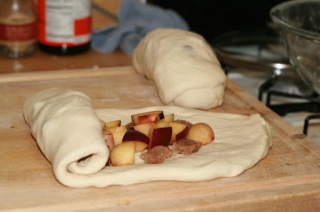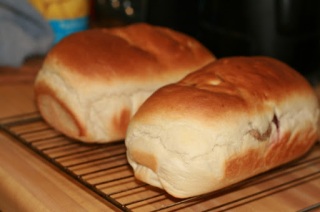For those of you who know me well, I bake when I am stressed. That does sound like my baked goods are full of vengeance and aggressiveness, but fortunately, they do not. The motion of creaming the sugar and butter together and kneading are very relaxing, and I usually do those by hand. I have a mixer, but for some reason I am very dubious of it. As I grew up, my father prepared our meals and he is a firm believer that “you can make whatever that they sell outside.” I remembered once I cajoled my mom to take my sister and me to get some Chinese version of popcorn chicken from a street vendor (not the KFC variety, flavored with white pepper, salt, and fried basil). When we returned, I saw my dad’s face darkened. The next day, he walked out from the kitchen with his version of the same popcorn chicken. While serving his creation, he murmured “this one is healthier for you. Why eat out when you can make it at home?” In addition, he is a tea-maker; he processes the tea leaves by hand, so as you can see, I have fond memories of handmade and homemade goodies.
Part of my morning e-mail routine is reading a daily newsletter from Küchengötter, the Kitchen Gods. Thanks to my friend Marianne’s suggestion, the ewsletter contains of recipes for three meals. What usually attracts my attention is bread, since Germany is famous for rustic variety. The challenge is that the newsletter is in German, so it is also a good way for me to maintain/ improve my German reading proficiency.
One of the recipes I perused recently is Pflaumenstange mit Marzipan, Marzipan Plum Bar. Honestly, it is the word Marzipan that caught my eyes. I have this odd fascination on Marzipan, sweetened almond paste. I first tasted when the Baker brought home some of his baked goods while he was in culinary school. It was almost love at first sight; the tender sweetness of the almond enhanced the delicate cake. I was so distracted by Marzipan to the extent that I forgot which cake is it.
Since plums are in season and I happened to have almond paste in the fridge, making the bread should be easy, right? Well, I underestimated Marzipan. It turned out that the almond paste was as hard as a rock, so no matter how I tried to mix it with confectioner’s sugar and a bit of corn syrup, it still looked like Dippin’ Dot ice cream. I added in a bit more syrup then the mixture started to resemble my impression of Marzipan. Long story short, the bread was fragrant, but due to the high sugar content, the inner was closer to molasses than an actual fruit bread.
After the first fail attempt, I started searching for Marzipan recipes. Thankfully I did not have to try it out three times to make it a charm, otherwise, I would probably have phobia toward Marzipan. I incorporated almond meal, sugar, and egg white for the Marzipan, and make the bread part same as my first attempt. I felt the trepidation when I put the doughs into the oven, but lucky me, I had a happy ending. I actually did not know what to expect on the flavor aspect, since this is my first time making a fruit bread. I thought it will turn out sweeter, given the plum and Marzipan combination. The bread turns out a bit salty. Yes, you read it right, salty, which still puzzles me. The recipe calls for 15g of salt, which I dutifully measured out, but I do not think the amount of salt could render the bread salty. As of the inside, it has a delicate sweetness to it, along with a bit of wine aftertaste since the plum pieces are slightly fermenting in the process of baking.
Here are the recipes:
Marzipan
Since plums are in season and I happened to have almond paste in the fridge, making the bread should be easy, right? Well, I underestimated Marzipan. It turned out that the almond paste was as hard as a rock, so no matter how I tried to mix it with confectioner’s sugar and a bit of corn syrup, it still looked like Dippin’ Dot ice cream. I added in a bit more syrup then the mixture started to resemble my impression of Marzipan. Long story short, the bread was fragrant, but due to the high sugar content, the inner was closer to molasses than an actual fruit bread.
After the first fail attempt, I started searching for Marzipan recipes. Thankfully I did not have to try it out three times to make it a charm, otherwise, I would probably have phobia toward Marzipan. I incorporated almond meal, sugar, and egg white for the Marzipan, and make the bread part same as my first attempt. I felt the trepidation when I put the doughs into the oven, but lucky me, I had a happy ending. I actually did not know what to expect on the flavor aspect, since this is my first time making a fruit bread. I thought it will turn out sweeter, given the plum and Marzipan combination. The bread turns out a bit salty. Yes, you read it right, salty, which still puzzles me. The recipe calls for 15g of salt, which I dutifully measured out, but I do not think the amount of salt could render the bread salty. As of the inside, it has a delicate sweetness to it, along with a bit of wine aftertaste since the plum pieces are slightly fermenting in the process of baking.
Here are the recipes:
Marzipan
- 1 Cup of Almond meal
- 1/2 Cup of sugar
- 1 eggwhite
Gently incorporate all three ingredients together. Be careful not to overmix it because you do not want the egg white to separate. Once it is mixed, wrap it in plastic wrap and refrigerate for 1-2 hours. This recipe should yield 200g of Marzipan.
Pflaumenstange (adapted from Küchengötter)
- 150 g Marzipan
- 250 g firm plums, quartered
- 25 g Yeast
- 300 ml water
- 20 g sugar
- 500 g flour
- 20 g butter
- 15 g salt
- Parchment paper
- Make or chill the marzipan before you make the dough for at least 1-2 hours, so it will stay in shape.
- Dissolve yeast and sugar with enough water. Make sure the water is about the same temperature as the yeast. Set it aside.
- Quartered the plum while wating the yeast/ sugar mixture dissolves.
- Stir the yeast mixture gently. When most granules disappear (slight bubbling), it is ready to go.
 |
| Yeast eating happily. Do you see all the effervescence? Happy yeast makes delicious bread. |
- Add in the rest of the ingredients, and knead the dough when it begins to form.
- Knead the dough until the surface is smooth. You can use to poking test. If the dough bounces back right after you poke, it is ready to rest. Cover the bowl with a moist towel. Rest the dough until it proofs twice of its size, about 40-60 minutes.
 |
|
| Ready for proofing! |
 |
| Dough after first proofing, with many air bubbles, as you can see the blister-like pockets on surface |
- Line the loaf pans with parchment paper.
- Scrape the dough out of the bowl and portion it in half (or size that you desire). Flatten the dough and gently stretch the corner to an elongated shape. Slice the rolled marzipan into smaller size and lay out both marzipan and quartered plum onto the stretched dough.
 |
| Line them up! |
- Slowly roll the dough, and tuck both ends under. Lay the dough into the parchment lined pan. Cover the pan with a moist towel for 20 minutes.
 |
| Almost like a burrito, but not quite |
 |
| loaf with tucked ends |
- While the dough undergoes second proofing, preheat the oven to 400 ºF. Put a boiler pan inside the oven as well.
- Before putting the dough, carefully put 4 ice cubes into the boiler pan, then place the loaf pans in and quickly close the oven door. The ice cubes in boiler pan are meant to give more humidity inside the oven, to give the crusty exterior to the bread. Do not put too many ice cubes in, otherwise the bread will not rise properly.
- To judge whether the loaves are done is the tricky part. When the loaves turn golden brown on top, it is usually a good indication that the loaf is done. Use offset spatula to flip the loaf over to see whether the bottom browns as well. When the loaves are done, remove it from loaf pan and set them on the rack to cool.
PS. This post is dedicated to my friend Marianne, who inspires me to attempt bread making. This Pflaumenstange was actually made on her birthday 🙂



I think moderation is the key here 😉
LikeLike
Talents? More like I am avoiding doing something that I really ought to focus on 🙂 Too bad bread does not travel well, otherwise, I will be more than happy to send you some. Baking is very similar to conducting a chemical experiment, since measuring has to be precise. Since you have extensive background and training in it, you should definitely give it a try!
LikeLike
Perhaps it is good that I don't live next door to you after all. I'm very close to my pre-college weight at the moment and need only muscle toning. I fear that I will bloat up like a whale due to excess of caloric intake–no matter how homemade and healthy.
LikeLike
WHOA! This looks DELICIOUS! I truly am so amazed by all your talents (particularly the baking *DROOL*). I love the recipes you try. They're so unusual but sound so tasty! One day when I conquer knitting, I may try my hand at baking heehee!
LikeLike